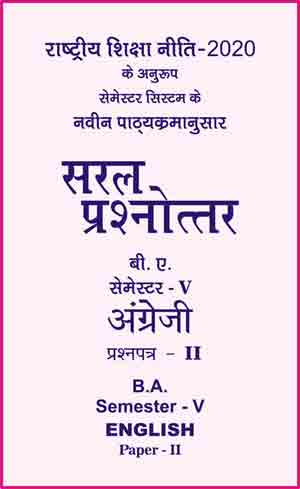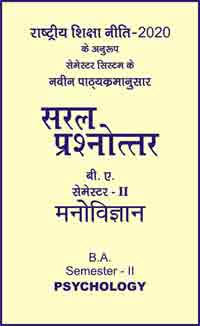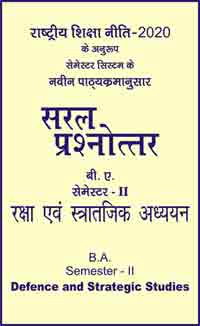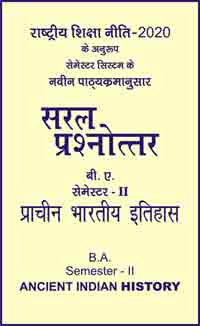|
बी ए - एम ए >> बीए सेमेस्टर-5 पेपर-2 अंग्रेजी बीए सेमेस्टर-5 पेपर-2 अंग्रेजीसरल प्रश्नोत्तर समूह
|
5 पाठक हैं |
|||||||
बीए सेमेस्टर-5 पेपर-2 अंग्रेजी - सरल प्रश्नोत्तर
Chapter - 10
- Ernest Hemingway
Question - Comment upon the role of the lions in The Old Man And The Sea.
Or
Explain the symbolism implied in the depiction of the lions in the novel The Old Man and the Sea'.
Answer-
Critics after critics have showered eulogies upon the heroic character of Santiago. This strong man struggling to survive amid the hostile pressures despite his several handicaps aroused the admiration of all and sundry. He proves that even a simple man is capable of decency, dignity and even heroism. He goes into the sea determined not to come back without catching a fish. For the last eighty four days he has not been successful but he goes on unfailing, undeterred. In his struggle whenever the old man feels the need to revitalize his energy, to shake of his depressive thoughts and to fill himself with resolution, courage and fortitude once again, his conjures up some dreams, day dreams and visions. "Hemingway'. says Katherine T. Jobes, "depicts in circumstantial detail the elemental tests of endurance........ to which Santiago is subjected and also his courageous response, summoning both physical energy and imaginative vision to counter the forces testing him.' Santiago thinks of Manolin, his young disciple or of Joltin' Joe Di Maggio the legendary New York center fielder whenever he feels that he will not be able to continue with his struggle any more. He has to prove it to Manolin that he is still capable and he wants to be "worthy of the great Di Maggie who does all things perfectly even with the pain of bone spur in his heel." He thinks of these two and feels energy flowing through his exhausted veins once again. Similarly whenever the old man wishes for peace and sleep he recalls his memory of stand-ing one evening on the deck of a square-rigged ship and seeing lions frolicking on the African beaches.
Even before the start of his great struggle against Marlin we see the old man sleeping on the old newspapers and dreaming of African beaches- long, golden and white. In his dreams he smells of Africa and sees the lions playing on the beach. He recalls the day dream when he wishes, on the afternoon of the second day of his struggle, that he could sleep and dream about the lions. When he sleeps that night he "began to dream of the long, yellow beach and he saw the first of the lions come down on to it in the early dark and then the other lions came and he rested his chin on the wood of the bows where the ship lay anchored with the evening off-shore breeze and he waited to see if there would be more lions and he was happy" Likewise, at the novel's end he sleeps, dreaming the narrator writes. of the lions.
The lions are the kings of the jungle. They rule over the forest by their courage, their strength, their fierceness and their supposed pride, But in Santiago's dreams the lions do not come as ferocious beings inspiring fear. The lions there are unusually domesticated and are pictured as engaged in non- predatory activities. "They have put aside their majesty and have grown Jo mestic and familiar. It is as if they gave themselves up to the old man, to his love, without the necessity of further trial or guilt or suffering. As the lions come out of the jungle and fill the old man's sleep, their cat-like playfulness, free of threat or challenge suggests a harmony between the old man and the heroic quali- ties which the lions possess and the giant marlin possessed and which the old man has fought to realize in himself. Most simply, perhaps, they suggest und achieve intimacy between the old man and the proud and often fierce heart of nature that for him is the repository of values." -(Arvin R. Wells)
The lions, in old man's mind, are also the symbols of his youthful energy. He had seen these lions in his youth when all his powers were in their prime. Now, when he has become old he feels the need of dreaming and dreams of these lions. This is nothing else but the old man's desire to live in his youth again-the wish to regain the vitality of young age which has long slipped through his fingers. The memory of those lions jumping upon the beaches with enthusiasm and cal symbolises for the old man the youthful vitality and makes him fight his battle with a revitalized vigour.
Carlos Baker has presented a different interpretation. He has drawn our attention to fundamental psychological laws of Santiago's nature in which the lions have became integrated. The memory of Manolin exhorts the old man to rise, to exert himself, to try harder whereas the remembrance of the lions makes relaxation descent on him. To borrow Carlos Baker's own words. "This is the constant wave like operation of bracing and relaxation. The boy braces, the lions relax as in the systolic-diastolic movement of the human heart." All around ourselves we see the same course followed in nature. Here day is followed by night which relaxes the exhausted creatures and prepares them for exertion once again on the next day. Similarly Manolin's memory puts the old man to work and that of the lions brings back to him the energy lost. during the period of activity.
Some analysts have presented a negative interpretation and said that the presence of the lions only brings forward a few weaknesses in the personality of the old man. Both Santiago and the narrator speak of the old man's strangeness. "1 am a strange old man", Santiago declares to Mandolin at the Terrace and on the second day of his ordeal against the giant fish, he reminds himself that "I told the boy I was a strange old man........ Now is when I must prove it." The reality. however, is that Santiago has feet of clay and indulges in the ordinary wish to he recognised as an individualist who stands out from the crowd. To prove his self- declared strangeness to the world he conducts himself according to an extraordinary set of standards. His identification with the lions is also only a revelation of "his wish for alliance with extraordinary animals", says Brenner. "He does not dream". Brenner goes on to assert. "Of monkeys, turtles, or hares strolling on an African beach. Only the king of heasts will do. That choice conscious or unconscious, betrays a desire to be associated with regal animals. to stand in the ranks of the prestigious lords of the universe, to be regarded as their equal, as one of them. Brenner calls such a desire to identify with lions infantile fantasies and opines that they are the results of protracted adolesence There is little" he says. "that is strange in such common delusions of grandeur. but Santiago failure to find anything amusing or pretentious about his leonme dreaming habit suggests his blindness to the ordinariness of his self-assigned strangeness. Such blindness invites pity or even scorn rather than respect" In one way, however. according to Brenner, the image of lions contributes to the old man's strangeness Santiago has been portrayed as a saintly, benevolent gentleman but at the same time he is guilty of several aggressive acts. His acts of aggression against the sharks are perhaps defensible. He kills them because these antagonists sought to violate his prize. His act of killing Marlin is occupationally defensible and the arm-wrestling with the Negro may also be defended, sublimated as it is in a competitive physical contest. But besides these, there are many other aggressive actions that prove his overtly violent inclinations. The event when he clubs to death the thwart-breaking, boat- banging, blood-spurting green fish may be cited as one such example. The saintly man having violently aggressive tendencies, is as much a contradictory portrayal as are the lions engaged in non-predatory activities. This says Brenner, "seems an appropriate image for Santiago to call on, consciously and unconsciously, if the narrator wishes to establish an alliance of strangeness between the lions and Santiago. For these unaggressive lions of Santiago's memory and dreams are as much a natural anomaly as is a fisherman with a reverentially fraternal feeling toward the natural world he preys on"
In his "The Snows of Kilimanjaro Hemingway used the image of a leopard. In that book he depicted a leopard frozen near the peak of a snow- covered mountai. This image is also open to several interpretations and has been variously explained by Hemingwagian analysts. Most importantly, however, the image of the frozen leopard suggests immortality. The leopard is frozen and cannot perish. Similarly we may suggest that the peaceful hons frolicking upon the sea-shores of Africa stand for more or less the same meaning. This image is frozen in the mind of the old man and stands for an era of calm and poise that can never really perish. All around the old fisherman marlins, sharks etc, are dying but what is immortal in his mind is not death or decay but peace and placidity. The lions playing "like young cats in the dusk". seems to indicate a beatific harmony between the old man and the creatures of the natural world.
|
|||||
- Question- Discuss in detail the development of English novel from the eighteenth century to the Modern Age.
- Question- What do you understand by Novel? What are the elements which are to considered in plot construction.
- Question- Write a note on characterization of a novel. How much is it important for development of a novel?
- Question- Write a short note on narrative technique of a novel.
- Question- Write a note on the elements of a short story.
- Question- Write a note on Fielding's plot construction.
- Question- Write a note on Fielding's characterisation.
- Question- Define plot. What are the qualities of an ideal plot ?
- Question- Write a short note on the plot construction of a novel.
- Question- What is the difference between Flat Character and Round Character?
- Question- Write a short note on the characterization of a novel.
- Question- Write a short note on narrative technique of a novel.
- Question- What is a short story? What is the difference between a short story and a novel?
- Question- What is a picaresque novel? Who are the main exponents of the picaresque novel?
- Question- What is a historical novel? What is the difference between history and a historical novel? Name a few historical novelists and their creation.
- Question- What do you know about the Gothic novel?
- Question- Write a note on Epistolary novel.
- Question- Write a note on the Regional novel.
- Question- Point out the chief characteristics of the Picaresque novel.
- Question- Point out the chief characteristics of the historical novel.
- Question- Write an essay on Sir Walter Scott's contribution to historical novel.
- Question- Point out the chief characteristics of Gothic novel.
- Question- Point out the chief characteristics of the Regional novel.
- Question- What is a regional novel? Name a few novelists of this genre and their novels.
- Question- What is a Picaresque novel?
- Question- What do you know about Historical novel?
- Question- What do you know about Gothic novel?
- Question- Examine the merits of Sir Walter Scott as a Historical novelist.
- Question- What do you mean by domestic novel?
- Question- What do you mean by the Stream of consciousness? Who. coined the term?
- Question- What is a Epistolary novel?
- Question- What do you know about the Regional novel?
- Question- Trends in 20th and 21st Century Fiction Discuss as a sub-genre of crime fiction and mystery.
- Question- Define utopian fiction. Discuss its history and origin.
- Question- What is campus novel? Explain its history and development.
- Question- Write a note on Detective novel.
- Question- Write a note on Science fictions.
- Question- Write a note on Meta fiction.
- Question- Define mythology. Explain the rise of mythological fiction in India.
- Question- What is space fiction? Discuss its characteristics and example.
- Question- Define chick lit. Discuss its characteristics and example.
- Question- Define junk fiction. Explain its characteristics and types of junk fiction.
- Question- Write a short note on detective novel.
- Question- Write short note on Science fiction.
- Question- What is Meta fiction?
- Question- What is Science Fiction?
- Question- What is utopian fiction?
- Question- Why are campus novels important? What kind of characters are in campus novels?
- Question- What is dystopian fiction?
- Question- Discuss feminism in mythological fiction.
- Question- Why are campus novels important? What kind of characters are in campus novels?
- Question- What is chic lit fiction?
- Question- Write a note on the life and works of Charles Dickens.
- Question- Write a note on Charles Dickens as a novelist.
- Question- Write a note on the development of English novel up to Dickens.
- Question- Write a note on Dicken's social criticism. What was Dickens' attitude toward various social evils of the day?
- Question- Describe Dickens as a representative of his age.
- Question- Write a note on Dickens as a social reformer.
- Question- Write a note on the social background of Dickens.
- Question- Write a note on Dickens's contribution to English novel.
- Question- Discuss symbolism as a structural elements in A Tale of two cities.
- Question- Discuss Dickens's art of characterization in the novel "A Tale of Two Cities".
- Question- What is meant by criticism of life? What is the 'vision of life"? Point out the criticism and vision of life in A Tale of Two Cities.
- Question- Write a note on the blend of realism and idealism in the novels of Dickens.
- Question- "Dickens' characters are both types and individuals.” Discuss.
- Question- Write a note on Dickens as a satirist.
- Question- What is the significance of the name "Jacques" in A Tale of Two Cities?
- Question- In Book 2, Chapter 21 of A Tale of Two Cities, what is happening in France that upsets Mr. Jarvis Lorry?
- Question- Write the life of Thomas Hardy and about his career.
- Question- What are the three phases of Hardy's writing? What were the issues he dealt with in those three phases?
- Question- Write short notes on the major characters of the novel, and show how Hardy develops these characters in the course of the novel.
- Question- Who is the heroine of 'Far From the Madding Crowd"? How doy o you justify her position as the heroine?
- Question- Explain the tragic vision of Hardy in Far From the Mad ding Crowd.
- Question- Why does Bathsheba reject Gabriel's proposal at the start of the novel?
- Question- How is sexual desire portrayed in the novel?
- Question- How was Oak's life saved by Bathsheba?
- Question- How was Oak completely ruined?
- Question- Describe the feast after sheep-shearing.
- Question- How are Oak and Bathsheba ultimately a happy couple?
- Question- Discuss Jane Austen as a realist.
- Question- Point out Jane Austen's contribution to the English novel.
- Question- Write a note on characterisation of Jane Austen with special reference to 'Pride and Prejudice'.
- Question- Is there artistic detachment in Jane Austen ? Write a brief note in support to your view with illustrations.
- Question- Sketch the character of Fitzwilliam Darcy.
- Question- Sketch the character of George Wickham.
- Question- Do you agree with the view that the novel 'Pride and Prejudice' revolves around two themes of 'Pride and Prejudice'? Give reasons for your answer?
- Question- Write an essay on the sequence of events in 'Pride and Prejudice'?
- Question- Write a note on Life Sketch of George Eliot Life Sketch of George Eliot
- Question- Discuss the humour elements in George Eliot's The Mill on the Floss.
- Question- Critically examine the artistic and the philosophic dimensions of the ending of The Mill on the Floss in the light of the view of the individual and society presented in the novel.
- Question- Compare and contrast Maggie's love for Philip, Stephen, and Tom.
- Question- Describe the thematic import of Maggie's decision to relinquish Stephen.
- Question- Compare and contrast Tom and Maggie. How much are their respective successes and failures a function of gender and how much a function of their distinct characteristics?
- Question- Compare and contrast Tom and Mr. Tulliver. Why does Tom succeed where Mr. Tulliver failed?
- Question- Write a note on life kketch of Toni Morrison.
- Question- Discuss the narrative strategies used by the writer in The Bluest Eye.
- Question- Discuss the narrative structure of the novel. Why might Morrison have chosen to present the events in a non- chronological way?
- Question- What does the title of The Bluest Eye mean?
- Question- How are Pecola Breedlove and Maureen Peal foils to one another?
- Question- The Bluest Eye uses multiple narrators, including Claudia as a child, Claudia as an adult, and an omniscient narrator. Which narrative point of view doyou think is most central to the novel and why?
- Question- Who do you think is the most sympathetic character in the novel and why?
- Question- The Bluest Eye is a novel about racism, and yet there are relatively few instances of the direct oppression of black people by white people in the book. Explain how racism functions in the story.
- Question- Write a note on Life Sketch of The Harper Lee.
- Question- Analyze the childhood world of Jem, Scout, and Dill and their relationship with Boo Radley in Part One.
- Question- What is Atticus's relationship to the rest of Maycomb? What is his role in the community?
- Question- Discuss the role of family in To Kill a Mockingbird, paying close attention to Aunt Alexandra.
- Question- Discuss the author's descriptions of Maycomb. What is the town's role in the novel? Analyze the author's treatment of Boo Radley. What is his role in the novel?
- Question- Discuss Atticus's parenting style. What is his relationship to his children like? How does he seek to instill conscience in them?
- Question- Identify Atticus Finch, Jean Louise (Scout) Finch, Jem Finch, Maycomb, Calpurnia, Charles Baker (Dill) Harris, The Radley Place, Stephanie Crawford, Arthur (Boo) Radley, Miss Caroline Fisher, Walter Cunningham, and Burris Ewell.
- Question- Why did Mr. Cunningham's mob leave?
- Question- In Chapter 2 of To Kill a Mockingbird what does Miss Caroline, Scout's first-grade teacher, represent?
- Question- In Chapter 6 of To Kill a Mockingbird why is Jem is determined to retrieve his pants from the fence despite the danger of meeting up with Nathan Radley?
- Question- What is the significance of the title To Kill a Mockingbird according to Atticus's reasoning in Chapter 10?
- Question - Comment upon the role of the lions in The Old Man And The Sea.
- Question- Comment upon the symbolic role played by Di Maggio in the novel "The Old Man And The Sea'...
- Question- Comment upon the arm-wrestling episode in the novel 'The Old Man and The Sea'.
- Question- Comment upon the marlin separating episode in the novel "The Old Man and The Sea".
- Question- Write a note on the major themes of the novel The Old Man and The Sea'.
- Question- Write a brief note on The Old Man And The Sea' as a tragedy.
- Question- Which claims your attention more in The Old Man And The Sea' its narrative or allegory?
- Question- The hero of the novel "The Old Man And The Sea' is really a Christfigure. Comment.
- Question- Write a brief note on Hemingway hero or the autobiographical hero.
- Question- In the fight of the old man against the giant fish what we see is a "battle of attrition". Comment.
- Question- Write a note on Life Sketh of John Ernst Steinbeck.
- Question- Analyze Tom Joad's growth throughout the novel. Despite the fact that Tom is not a young boy, does the novel have the characteristics of a bildungsroman, or coming-of-age story?
- Question- Discuss the development of Tom Joad as a character. How does he grow throughout the book? What effects do Jim Casy's imprisonment and death have on his development?
- Question-What themes related to family are in The Grapes of Wrath?
- Question- How does the erosion described in Chapter 1 of The Grapes of Wrath relate to the Bank monster described in Chapter 5?
- Question- How do the roles of Ma and Pa differ in the Joad family in The Grapes of Wrath?
- Question- In The Grapes of Wrath how is the Gila monster described in Chapter 13 comparable the Bank monster?
- Question- What biblical allusions does John Steinbeck include in The Grapes of Wrath and how does he use them?
- Question- How do the roles of Ma Joad and Pa Joad within the family change in The Grapes of Wrath?
- Question- In The Grapes of Wrath, why does the Joad family deteriorate after the Joads leave Oklahoma?
- Question- Write a note on Life Sketch of Aravind Adiga
- Question- Discuss plot of the novel The White Tiger.
- Question- Explain literary analysis of The White Tiger by Aravind Adiga.
- Question- Critical analysis of the novel The White Tiger written by Aravind Adiga.
- Question- What is Balram's attitude toward religion? How does this develop throughout the novel?
- Question- How does this portrayal of India differ from more typical literary depictions of India?
- Question- Why does Balram choose to address his narrative to the Premier of China? How would the story have been different without this framing device?
- Question- Discuss Balram's many names throughout the novel, and how each one represents an aspect of him.
- Question- What does Balram's experience in Bangalore reveal about the Indian economy in an increasingly globalized world?
- Question- Attempt critical analysis of the novel 'Dalits, Dynasty and She' by Sanjay Chitranshi.
- Question- Explain the plot of the novel 'Dalits, Dynasty and She 'written by Sanjay Chitranshi.
- Question- Discuss the Novel 'Dalits, Dynasty and She' by Sanjay Chitranshi.
- Question- Who was Shanti Devi?
- Question- Write a' character sketch of Ram Chandra.
- Question- Write a note on Life Sketch of Sudha Murty.
- Question- What are the major themes of the novel "Dollar Bahu"?
- Question- Discuss how the notion of self sacrifice is exclusively attributed to a particular gender in Indian society. How they thrive through the difficult situation in life when they are implanted to a new atmosphere.
- Question- Write a note on the title "Dollar Bahu?".
- Question- Write a note on the end of the novel "Dollar Bahu".
- Question- Discuss the central theme of Dollar Bahu.














